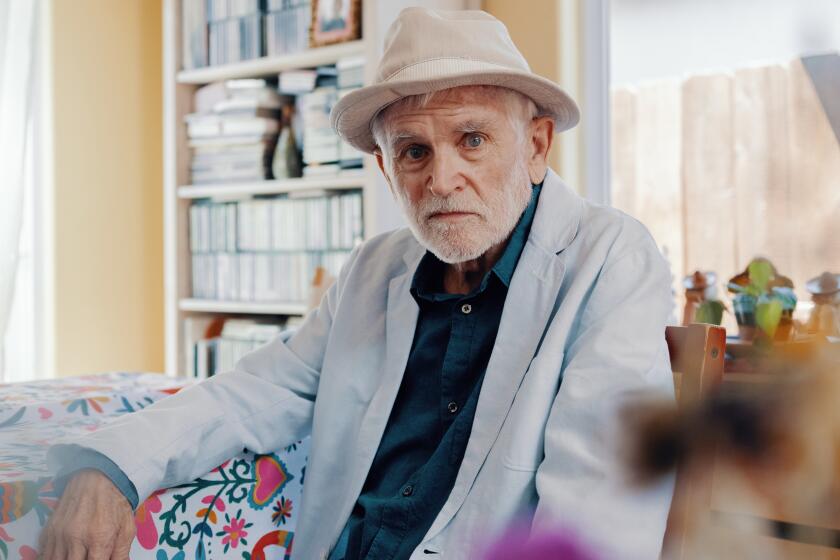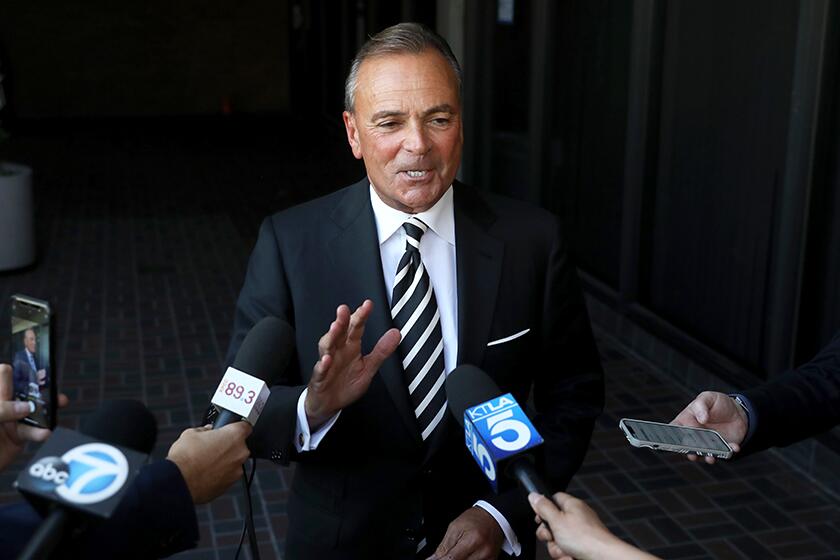Subway Showcase : Public art: Metro Red Line stations will have murals, neon sculptures and other works with distinct designs at each stop on the route. Officials say installations will curb vandalism.
- Share via
Hundreds of feet beneath a bland landscape of strip malls and endless sprawl, there soon will be the stylish architecture, public art displays and creative planning rarely seen above ground in Los Angeles.
The first phase of the Metro Red Line subway system, expected to open next month, will feature neon sculpture, murals by Latino artists and avant-garde artworks showcased in stations designed by some of the city’s most highly regarded architects.
These five stations are part of what Art in America magazine calls the country’s “most ambitious art-in-transit program.” By the end of the decade more than 50 subway and commuter rail stations throughout the county will display distinctive artworks, with many of the artists working with architects to design innovative stations.
Despite budget shortages, the Los Angeles County Transportation Commission has made art and architecture a high priority in its stations’ designs--in part for aesthetics but more important because officials believe that it will help coax people out of their cars.
“People in Los Angeles who are not used to subways may be reluctant to go underground to some dark and dingy space to take a train,” said Jessica Cusick, director of the LACTC’s Art for Rail Transit Program. “But if the stations are open and filled with light and display great art, people will be more likely to try it.”
The 4.4-mile section of the Red Line that opens next month includes the Pershing Square station, which features 12 neon artworks hanging from the ceilings and columns. At the 7th Street/Metro Center station there are two long, narrow ceramic tile murals, designed to look like strips of film that depict movie characters and scenes.
At Union Station there is a large mural that shows travelers from different eras of Los Angeles, from Spanish conquistadors to actress Carole Lombard, sitting on a suitcase, sullenly staring off into the distance. At the Civic Center station, a display called “I Dreamed I Could Fly” features six nearly life-size fiberglass figures suspended from the ceiling by wires. A tape of intermittent bird chirps and trills is broadcast from station speakers.
Commuters might find this a bit esoteric and prefer that the funding--more than $100,000 a station--be used instead to reduce ticket prices. And with the LACTC under fire for alleged misuse of Metro Rail funds, the agency could draw criticism for installing expensive artwork in a city where graffiti vandals have caused millions of dollars in damage.
But Jacki Bacharach, an LACTC commissioner, said the subway systems throughout the world that are the best maintained and suffer the least vandalism are well designed and have prominent public art displays.
“The RTD spends $12 million a year removing graffiti off buses. . . . That’s just like throwing the money down a rat hole,” she said. “If we can get people to better respect these stations, the money for public art will be well spent.”
The art program requires that all works be durable for at least 25 years and resistant to vandalism, Cusick said. And although not everyone “will grasp the artists’ complete concept or vision, all the works can be appreciated on different levels . . . and most people will get at least a smile, a chuckle or a flash of inspiration from them,” she said.
Riders will appreciate the stations, Cusick said, because most will reflect something about the neighborhood and its residents.
The Westlake-MacArthur Park station is in a largely Latino neighborhood, so its design uses “bold colors and simple geometric forms like a Diego Rivera painting,” said architect Marv Taff of Gensler and Associates in Santa Monica. In the station’s plaza there is a large, three-dimensional red tile circle and blue tile square--which frame the entrances to escalators that lead to the subway--and a bright yellow tile tower that encases the skylight.
Near the train platforms are two huge murals, also using bright primary colors, created by Chilean-born artist Francisco Letelier. Called “El Sol” and “La Luna” (“The Sun” and “The Moon”), they were partly inspired by two ancient temples in Mexico, Letelier said. The theme captures “some historical landmarks the Latino population will relate to,” he said, and also is relevant for commuters leaving in the morning and returning at night.
The architects designed the stations for the first phase of the Red Line and for the entire Blue Line, which runs between Long Beach and downtown Los Angeles. Then the artworks were commissioned. But the artists and architects--most of whom are from Southern California--collaborated from the beginning on the design of the second phase of the Red Line that will extend into Hollywood by the end of the decade, and the Green Line stations, which will run from Norwalk to El Segundo by 1994. As a result of this collaboration, Cusick said, these stations will be more distinctive.
The plans for the station at Vermont Avenue and Santa Monica Boulevard has won a national design award from Progressive Architecture magazine. The station, designed by architect Mehrdad Yazdani and artist Robert Millar, is highlighted by a 30-foot tall, almond-shaped, metal sculpture that serves as a canopy for the entrance.
As riders descend on the escalator into the station, the area is flooded with light from an enormous skylight. On the beams that support the skylights are 24 “light-reflective paintings,” Millar said, made of glass and aluminum.
“In most subway tunnels the deeper you go the darker and colder and more confined it gets . . . but with this space it’s the opposite effect,” Millar said. “For a city where people are accustomed to sunshine and the outdoors, this will prove more successful.”
The station at Vermont Avenue and Sunset Boulevard incorporates many neighborhood landmarks. The Griffith Observatory inspired the large metal dome above the elevator shaft and the floor pattern is inlaid with planets and astronomical signs. Mayan symbols on the walls are similar to those at the nearby Hollyhock House designed by Frank Lloyd Wright.
At Hollywood and Vine, the station reflects all the “glitter, glamour and glitz of Hollywood,” said artist Gilbert (Magu) Lujan. The station will be designed to resemble the interior of one of Hollywood’s grand movie palaces, with vaulted ceilings above the platform covered with 16-millimeter film reels, a star motif--from the light fixtures to the floor and wall patterns--and huge columns designed to look like palm trees.
Riders follow a yellow brick road from street level to the ticket machines and down to the station platforms. A row of video screens, playing old movies and new video shorts, will flank the walls. And the handrails leading down into the station will be composed of stainless steel musical notes--the score to the song “Hurray for Hollywood.”
“We’ve tried to give each station an identity, so when you travel on the subway you don’t need a sign to tell you where you are,” said architect Jorge Hernandez, who was project manager for the design of the Hollywood and Vine station. “Some of these stations will be so distinctive they’ll almost be like galleries.”
Other cities, such as Seattle and Boston, have installed public art in subway stations. But Los Angeles County’s 150-mile commuter rail system will be the first in the country where there is public art in every station, Cusick said.
The cost of the art program ranges from $100,000 to $200,000 for subway stations, and $50,000 to $100,000 for light rail stations. The majority of the cost is for materials and installation, with about 15% going for the artists. The station art is funded through the LACTC, which allocates to the program 0.5% of the construction costs for the rail system.
Some communities and businesses were so enthusiastic about the program that they donated funds to make the stations more elaborate. The city of Redondo Beach donated $460,000--using funds available to cities from a sales tax measure--and TRW spent $100,000 on the Marine Avenue Green Line station.
The open-air station, which incorporates ocean and aerospace themes, will be covered with a canopy of curved glass with flowing water that looks like a cresting wave. On top of the elevator towers will be metal sculptures that look like satellites, and the paving pattern on the platform will display orbital maps, planets and a concrete cast depicting Neil Armstrong’s first step on the moon.
“We wanted something very different than the sleazy New York-style subway that takes you across town,” Redondo Beach Mayor Brad Parton said. “If you have something like that in L.A., people will just stick to their cars. We wanted to deter graffiti and really encourage people to use the system . . . and to do that we felt we needed something a cut above the generic station.”
Art in Transit Los Angeles architects are combining their talents with artists to give underground Metro Red Line stations an avant-garde look. The five stations in the first phase of the Metro Red Line feature: PERSHING SQUARE STATION Architect: Arthur Erickson Architects. Art: “Neons for Pershing Square,” a neon sculpture by Stephen Antonakos. 7TH STREET/METRO CENTER STATION Architect: Dworsky Associates. Art: “The Movies: Fantasies” and “The Movies: Spectacles,” hand-painted ceramic tile works by Joyce Kozloff. “Unity,” a series of fiber-optic panels by Tom Eatherton. “Heaven to Earth,” a three-part ceramic tile mural by Roberto Gil de Montes. WESTLAKE/MACARTHUR PARK STATION Architect: Gensler and Associates. Art: “El Sol” and “La Luna,” two ceramic tile murals by Francisco Letelier. Untitled, a series of figures suspended from the skylight by Therman Statom. UNION STATION Architect: Harry Weese & Associates. Art: “Traveler,” a ceramic tile mural by Terry Schoonhoven. “City of Angels,” an aluminum sculptural mural by Cynthia Carlson. “Union Chairs,” multicolored granite chairs by Christopher Sproat. CIVIC CENTER STATION Architect: Arthur Erickson Architects. Art: “I Dreamed I Could Fly,” six fiberglass figures by Jonathan Borofsky.
More to Read
Sign up for Essential California
The most important California stories and recommendations in your inbox every morning.
You may occasionally receive promotional content from the Los Angeles Times.










